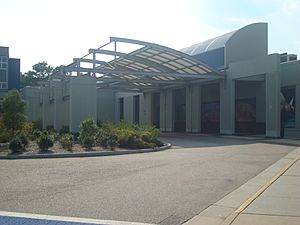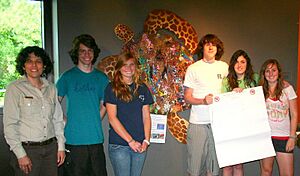Virginia Aquarium facts for kids

Virginia Aquarium Main Entrance
|
|
| Location | Virginia Beach, Virginia, USA |
|---|---|
| Coordinates | 36°49′16″N 75°59′02″W / 36.82105°N 75.98377°W |
| No. of animals | 12,000 |
| No. of species | 700 |
| Total volume of tanks | 800,000 US gallons (3,028,000 L) |
| Memberships | AZA, AMMPA |
The Virginia Aquarium & Marine Science Center is an amazing place in Virginia Beach, Virginia. It's both an aquarium and a marine science museum! You can explore over 800,000 gallons of fresh and saltwater tanks here. It's packed with incredible animals from rivers, bays, and the ocean.
Contents
A Look Back in Time
The Virginia Aquarium first opened its doors on June 14, 1986. Back then, it was called the Virginia Marine Science Museum. Its main goal was to show off life from Virginia's rivers, the Chesapeake Bay, and the nearby ocean.
In 1995, the aquarium grew much bigger, tripling its original size. Then, on November 21, 2009, a huge new area called "Restless Planet" opened. This $25 million project added exciting new habitats. These included a Malaysian Peat Swamp, a Coastal Sahara Desert, a Red Sea exhibit, and a recreation of Indonesia's Flores Island. This expansion doubled the number of animal species at the aquarium. Some cool new animals like Komodo dragons, tomistomas, and spotted eagle rays joined the family.
Exploring the Exhibits
The Virginia Aquarium has two main exhibit buildings: the Bay and Main Building and the South Building. A fun one-third mile outdoor nature trail connects them. This trail runs right next to the Owls Creek Salt Marsh. The area also has an Adventure Park, which is a rope climbing course. Together, the two buildings are home to more than 12,000 animals. These animals represent over 700 different species!
Main Building Highlights
The Main Building shows how water travels from Virginia's rivers, through the Chesapeake Bay, and out to the big ocean. The "Restless Planet" exhibits in this building also show how powerful natural forces shaped Virginia's landscape.
Chesapeake Bay Aquarium
The Chesapeake Bay Aquarium starts with a special touch pool. Here, you can gently touch animals like horseshoe crabs, Forbes' sea stars, and whelk. The rest of this exhibit features animals that live in the shallow waters around the Chesapeake Bay Bridge-Tunnel. You might see hermit crabs, spider crabs, and small fish like Hypsoblennius hentz.
Norfolk Canyon Aquarium
The Norfolk Canyon Aquarium lets you explore an underwater canyon. This canyon is about 70 miles off the coast of Virginia. This exhibit is home to different kinds of sharks, including sandbar sharks, nurse sharks, and sand tiger sharks. You can also spot fish like crevalle jacks, grey triggerfish, and southern stingrays.
Chesapeake Light Tower Aquarium
The 70,000-gallon Chesapeake Light Tower Aquarium shows what life is like up to about 15 miles off Virginia's coast. This huge tank is home to amazing sea turtles like loggerheads, green sea turtles, and Kemp's ridley sea turtles. Many fish also swim here, including Atlantic spadefish, a giant Atlantic goliath grouper, Atlantic tripletail, cobia, lookdown, and permits.
Restless Planet
The "Restless Planet" area is an exciting expansion with five immersive displays. These include a Malaysian peat swamp, a coastal desert, a replica of the Mediterranean Sea, a 100,000-gallon Red Sea exhibit, and a recreation of an Indonesian volcanic island. There are also new hands-on exhibits. These show how natural forces shaped Virginia's land. Some of the animals you can see here are Komodo dragons, tomistomas, spotted eagle rays, zebra sharks, Egyptian cobras, hedgehogs, and cuttlefish.
South Building Wonders
The South Building features playful North American river otters, a red octopus, moon jellies, and many other animals. This building also gives visitors a peek behind the scenes. You can see the Vet Center, the Stranding Response Program, and the Water Quality Lab. There's also a big outdoor play area for kids. It has water tables, climbing nets, bubbles, and more fun activities.
The aquarium's Research and Conservation team runs the Stranding Response Program. This team helps sick or injured seals, dolphins, whales, and sea turtles found on local shores. The Marsh Pavilion, which was part of this area, closed for renovations on January 2, 2019.
Adventure Park
The Adventure Park at the Virginia Aquarium is an outdoor rope-climbing center. It's known as Virginia Beach's "largest and most exciting adventure park." It has over 250 different climbing challenges. There are also more than 30 ziplines, with the longest one stretching over 300 feet across the nearby creek!
Images for kids




